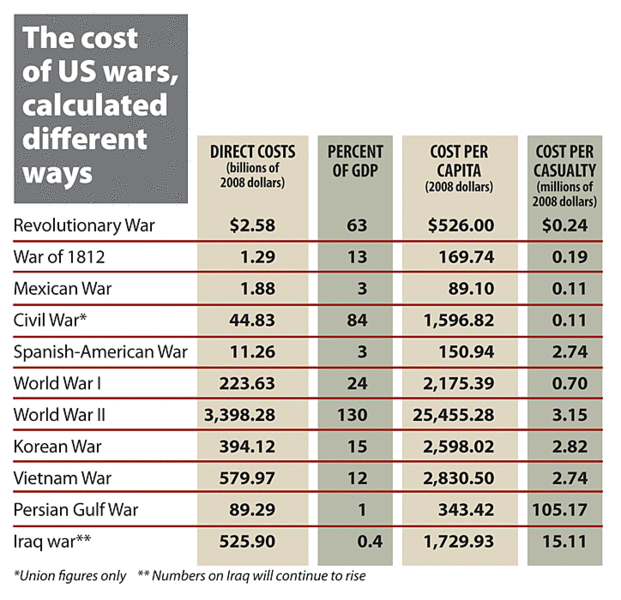How able are Americans to bear the costs of war?
Loading...
War in Iraq presents a paradox on the American home front: The military effort has had little discernible impact on most Americans, but by some forecasts, the Iraq effort will end up costing more per citizen than many US wars with higher numbers of casualties – Korea, Vietnam, and the Civil War.
It might seem as if a $1 trillion-plus war tab doesn't matter: Most Americans have been working and spending just as usual. Financial headlines have focused on everything from mergers to mortgages, but rarely on issues related to national defense.
"It's just a number to the American people," says Richard Kohn, a military historian at the University of North Carolina at Chapel Hill.
But the Iraq war has cost taxpayers about $526 billion so far – and could reach $2 trillion by 2017, according to one study by Congress's Joint Economic Committee. Chalk that up, in part, to interest on war debt and the likelihood that, even after a drawdown, many troops will remain in Iraq years.
The economy faces other war costs that will never show up in the federal budget. Consider the full long-term healthcare costs for those wounded, for example, and the lost productivity of family members who stay out of the workforce to care for them. These and other factors could bring the ultimate cost of the war as high as $3 trillion, according to a new book by economists Joseph Stiglitz and Linda Bilmes.
"As high as these financial costs are ... they don't really compare to the human costs," says Michael O'Hanlon, a defense policy expert at the Brookings Institution in Washington. In the decision whether to go to war, the budgetary costs remain subordinate to other factors, he says.
The Iraq costs add to the federal budget deficit, meaning America will be paying for it for years to come.
"It has weakened our fiscal position" for the long term, Mr. O'Hanlon says. "It hasn't really affected the economy too much otherwise."
To be sure, some pockets of America have felt a stimulus from the war.
In Mishawaka, Ind., workers cranked out Humvees bound for Baghdad.
Wilmington, N.C., was for a time a hive of activity.
"Certainly during the first year [of the war], when so much of the equipment and troops were coming out of the port of Wilmington, [it] reminded me of what I remember as a boy in World War II," says Wilbur Jones, a retired Navy captain who has written a book about the city's boomtown atmosphere.
But the comparisons with 60 years ago pretty much end there, says Mr. Jones.
"Today's citizens can buy airplanes and boats and automobiles" if they want, he says. That's a sharp contrast with his boyhood, when the consumer economy was largely put on hold except for necessities.
In fact, by some measures, the economic toll of war has been trending downward from earlier conflicts. The direct costs of Operation Iraqi Freedom, so far, total less 1 percent of one year's economic output (gross domestic product). That's down from 15 percent of GDP in the Korean War and 12 percent in the Vietnam War, according to research by William Nordhaus, a Yale University economist.
One reason for this shift: The GDP side of that equation has grown larger. The US costs of war are borne on the shoulders of the broadest economy in history. The cost per capita may be high compared with some past wars, but income per capita is higher still.
Yet another part of the equation has also changed. If the scope of a war can be implied in casualties, Korea and Vietnam were bigger wars, with about 34,000 and 47,000 battle deaths respectively, according to the Department of Defense. Some 4,000 have died in Iraq.
United States soldiers are increasingly well equipped, trained, and supported. But minimizing casualties costs money. Thus, spending in the Iraq war totals $15 million for each service member killed or wounded. By comparison, the cost per casualty was in the vicinity of $3 million between World War II and Vietnam.
"The logistics tail, or the support system behind the man carrying the rifle ... is enormous compared to other countries," Jones says. "Everything is just … much more expensive now."





